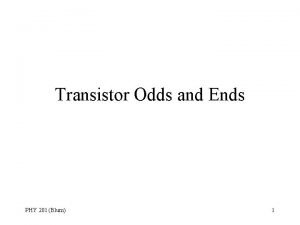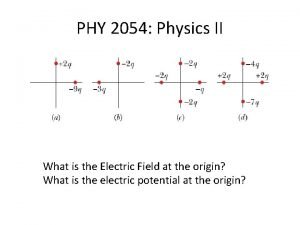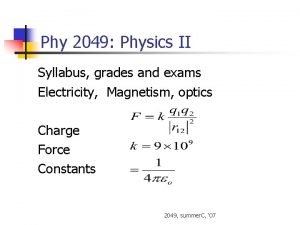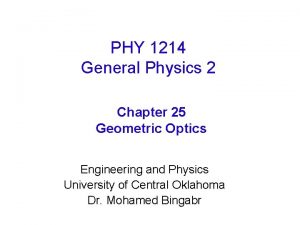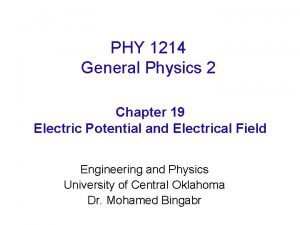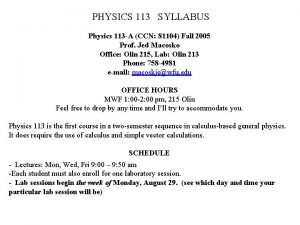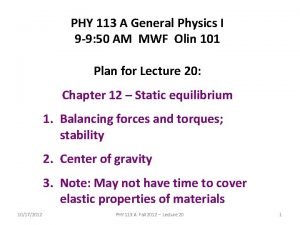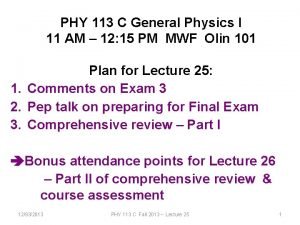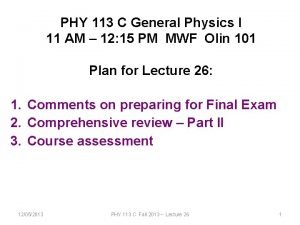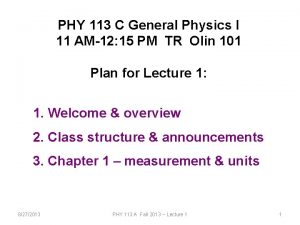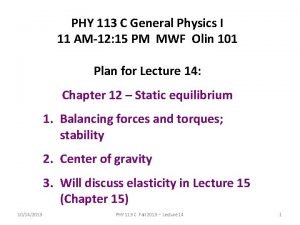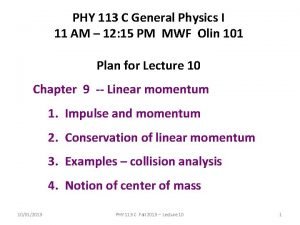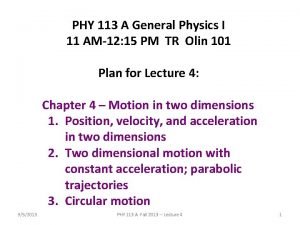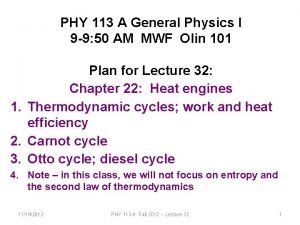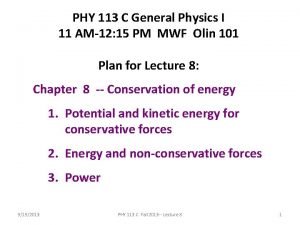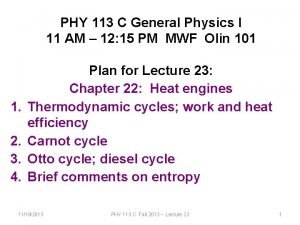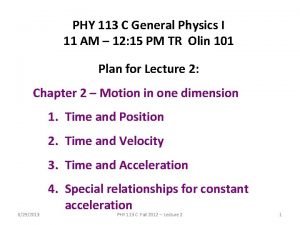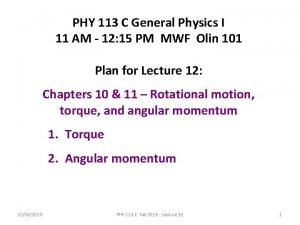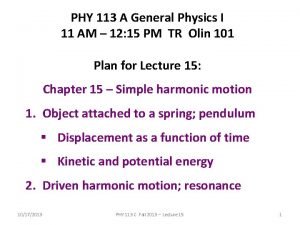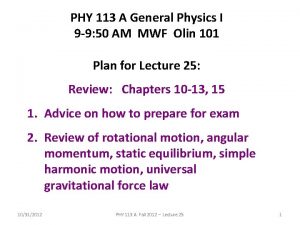PHY 113 A General Physics I 9 9


















- Slides: 18

PHY 113 A General Physics I 9 -9: 50 AM MWF Olin 101 Plan for Lecture 17: Chapter 10 – rotational motion 1. Angular variables 2. Rotational energy 3. Moment of inertia 10/10/2012 PHY 113 A Fall 2012 -- Lecture 17 1

10/10/2012 PHY 113 A Fall 2012 -- Lecture 17 2

Angular motion angular “displacement” q(t) angular “velocity” angular “acceleration” s “natural” unit == 1 radian Relation to linear variables: sq = r (qf-qi) vq = r w aq = r a 10/10/2012 PHY 113 A Fall 2012 -- Lecture 17 3

v 1=r 1 w r 1 w r 2 v 2=r 2 w Special case of constant angular acceleration: a = a 0: w(t) = wi + a 0 t q(t) = qi + wi t + ½ a 0 t 2 ( w(t))2 = wi 2 + 2 a 0 (q(t) - qi ) 10/10/2012 PHY 113 A Fall 2012 -- Lecture 17 4

A wheel is initially rotating at a rate of f=30 rev/sec. R 10/10/2012 PHY 113 A Fall 2012 -- Lecture 17 5

R 10/10/2012 A wheel is initially rotating at a rate of f=30 rev/sec. Because of a constant angular deceleration, the wheel comes to rest in 3 seconds. PHY 113 A Fall 2012 -- Lecture 17 6

Example: Compact disc motion w 1 w 2 In a compact disk, each spot on the disk passes the laser-lens system at a constant linear speed of vq = 1. 3 m/s. w 1=vq/r 1=56. 5 rad/s w 2=vq/r 2=22. 4 rad/s What is the average angular acceleration of the CD over the time interval Dt=4473 s as the spot moves from the inner to outer radii? a = (w 2 -w 1)/Dt =-0. 0076 rad/s 2 10/10/2012 PHY 113 A Fall 2012 -- Lecture 17 7

Object rotating with constant angular velocity (a = 0) w R v=Rw v=0 Kinetic energy associated with rotation: “moment of inertia” 10/10/2012 PHY 113 A Fall 2012 -- Lecture 17 8

Moment of inertia: iclicker exercise: A. a 10/10/2012 Which case has the larger I? B. b PHY 113 A Fall 2012 -- Lecture 17 9

Moment of inertia: 10/10/2012 PHY 113 A Fall 2012 -- Lecture 17 10

Note that the moment of inertia depends on both a) The position of the rotational axis b) The direction of rotation m m d d I=2 md 2 10/10/2012 m m d d I=m(2 d)2=4 md 2 PHY 113 A Fall 2012 -- Lecture 17 11

iclicker question: Suppose each of the following objects each has the same total mass M and outer radius R and each is rotating counterclockwise at an constant angular velocity of w=3 rad/s. Which object has the greater kinetic energy? (a) (Solid disk) 10/10/2012 (b) (circular ring) PHY 113 A Fall 2012 -- Lecture 17 12

Various moments of inertia: R R R solid cylinder: I=1/2 MR 2 10/10/2012 solid sphere: solid rod: I=2/5 MR 2 I=1/3 MR 2 PHY 113 A Fall 2012 -- Lecture 17 13

Calculation of moment of inertia: Example -- moment of inertia of solid rod through an axis perpendicular rod and passing through center: R 10/10/2012 PHY 113 A Fall 2012 -- Lecture 17 14

Note that any solid object has 3 moments of inertia; some times two or more can be equal j i k iclicker exercise: Which moment of inertia is the smallest? (A) i (B) j (C) k 10/10/2012 PHY 113 A Fall 2012 -- Lecture 17 15

iclicker exercise: Three round balls, each having a mass M and radius R, start from rest at the top of the incline. After they are released, they roll without slipping down the incline. Which ball will reach the bottom first? A 10/10/2012 B C PHY 113 A Fall 2012 -- Lecture 17 16

10/10/2012 PHY 113 A Fall 2012 -- Lecture 17 17

iclicker exercise: Three round balls, each having a mass M and radius R, start from rest at the top of the incline. After they are released, they roll without slipping down the incline. Which ball will reach the bottom first? A 10/10/2012 B C PHY 113 A Fall 2012 -- Lecture 17 18













